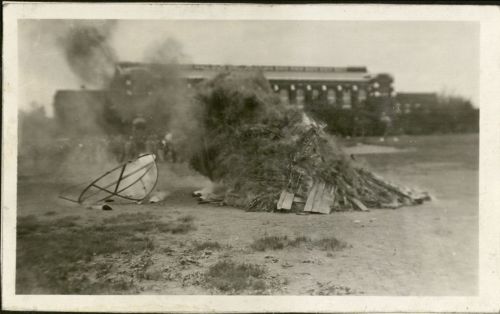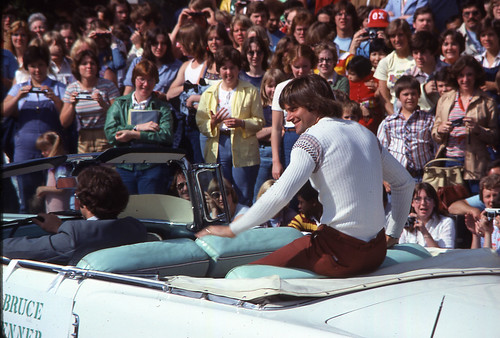 Education float from the 1922 Parade (addditional VEISHEA parade images can be found online, along with other VEISHEA images).
Education float from the 1922 Parade (addditional VEISHEA parade images can be found online, along with other VEISHEA images).
Next week marks the beginning of VEISHEA, Iowa State’s spring celebration and the largest student-run celebration in the country. In addition to all of the 2012 events going on throughout the week, VEISHEA will also be celebrating its 90th anniversary! VEISHEA was first celebrated in May 1922, a combination of Iowa State’s various spring celebrations which had previously occurred separately each spring: St. Patrick’s Day (Engineers), Ag Carnival (Agriculture), HEC Day (Home Economics Club), and May Day (started by Women’s Athletic Association).
What was that first 1922 VEISHEA like? The 1922 program for VEISHEA is available online, and gives a brief glimpse into the humor and activities which were a part of the first celebration, which took place May 11-13. As the program states, the reasons for an all-college celebration were:
“Primary Purpose of Exposition: To eliminate the break in college work caused by five divisional celebrations, on five week-ends of two terms.
Resulting Purpose of Exposition: To develop the spirit of unity, unity between Iowa State College and Iowa people, unity between AMES and high school students, unity between alumni and students, unity between the students of the five divisions.”
One could easily say that these purposes from that first VEISHEA ninety years ago are clearly not outdated ninety years later, but are still an almost unchanged, central part of our VEISHEA celebrations as this year’s 2012 theme illustrates: “VEISHEA, A Timeless Tradition”. In fact, the name of VEISHEA itself reflects the emphasis on unity Iowa State expressed, and continues to express, through its VEISHEA celebrations. VEISHEA is an acronym for the five divisions which in 1922 made up Iowa State: Veterinary, Engineering, Industrial Science, Home Economics, and Agriculture.
 1922 Physics float, complete with telescope, Benjamin Franklin, and Galileo.
1922 Physics float, complete with telescope, Benjamin Franklin, and Galileo.
A central event of the 1922 VEISHEA, as is still the case, was the parade. The 1922 VEISHEA parade began bright and early at 9 o’clock that Friday, May 12th morning. As the program states, “The VEISHEA parade…is the first big parade signifying the unity of the five divisions in one all-college exposition. The first part of the parade is a pageant developing the history of Iowa from the prehistoric glacial epoch to the present time; the rest of the parade shows Iowa State as we see it today and demonstrates in a small way what Ames is doing for Iowa.”
 As these parade images show, some floats were pulled by automobiles and others by horses. This horse-pulled float shows that “Hort products feed the world.”
As these parade images show, some floats were pulled by automobiles and others by horses. This horse-pulled float shows that “Hort products feed the world.”
In addition to the photographs and program, we have also recently made the programs for the 1922 May Fete and the 1922 Nite Show (which later became Stars Over VEISHEA) available online through Scribd.
Wondering how you can learn more about VEISHEA celebrations and its timeless traditions? Swing by the University Archives to look through our VEISHEA Records (the records are organized by decade, and the finding aids describing the contents can be found listed here under RS 22/12). In addition, we have many of our VEISHEA photographs available online. A selection of VEISHEA film footage can be found on our YouTube channel under Iowa State University Films. You can also page through The Bomb, Iowa State’s yearbook, to see a glimpse of each year’s VEISHEA. The Bomb available in the General Collection, call number LD2548 Io9b, or in the Special Collections’ Reading Room.
We also have an online exhibit about the history of VEISHEA. The exhibit contains a bibliography listing other resources related to VEISHEA available in our department. We also have several other blog posts related to VEISHEA: pre-VEISHEA celebrations, St. Patrick’s Day (engineers), and Stars Over VEISHEA.
These records and histories speak to us about the history of VEISHEA, but also about how those previous VEISHEAs helped set the stage for this year’s. As the 1922 program states:
“Next year, and in all the years to come, there will be greater and better Veisheas. Each succeeding year, it is hoped, will see greater and greater numbers of Iowans availing themselves of the opportunity to get acquainted with their college.”
Check out all of this year’s VEISHEA events and activities here!




























 Education float from the 1922 Parade (addditional VEISHEA parade images can be found
Education float from the 1922 Parade (addditional VEISHEA parade images can be found  1922 Physics float, complete with telescope, Benjamin Franklin, and Galileo.
1922 Physics float, complete with telescope, Benjamin Franklin, and Galileo. As these parade images show, some floats were pulled by automobiles and others by horses. This horse-pulled float shows that “Hort products feed the world.”
As these parade images show, some floats were pulled by automobiles and others by horses. This horse-pulled float shows that “Hort products feed the world.”


 Concession stand for the 1914 Ag Carnival. Student food stands can still be found on campus during VEISHEA.
Concession stand for the 1914 Ag Carnival. Student food stands can still be found on campus during VEISHEA. Cherry pies of the 1922 Home Economics Day.
Cherry pies of the 1922 Home Economics Day. Although not labeled as such, this 1910 image of the engineer’s St. Patrick’s Day celebration is probably their first parade one hundred years ago, on their way either to or from the “village” of Ames. Luckily the parade these days takes place in a much safer location!
Although not labeled as such, this 1910 image of the engineer’s St. Patrick’s Day celebration is probably their first parade one hundred years ago, on their way either to or from the “village” of Ames. Luckily the parade these days takes place in a much safer location!